Related Research Articles
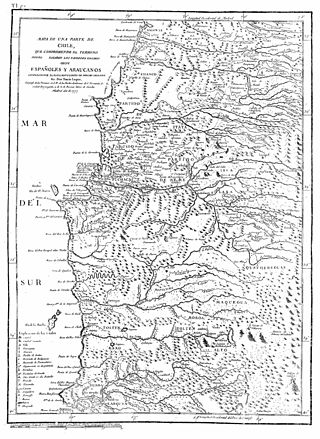
The Arauco War was a long-running conflict between colonial Spaniards and the Mapuche people, mostly fought in the Araucanía region of Chile. The conflict began at first as a reaction to the Spanish conquerors attempting to establish cities and force Mapuches into servitude. It subsequently evolved over time into phases comprising drawn-out sieges, slave-hunting expeditions, pillaging raids, punitive expeditions, and renewed Spanish attempts to secure lost territories. Abduction of women and war rape was common on both sides.

Toqui is a title conferred by the Mapuche on those chosen as leaders during times of war. The toqui is chosen in an assembly or parliament (coyag) of the chieftains (loncos) of various clans (Rehues) or confederation of clans (Aillarehues), allied during the war at hand. The toqui commanded strict obedience of all the warriors and their loncos during the war, would organize them into units and appoint leaders over them. This command would continue until the toqui was killed, abdicated (Cayancaru), was deposed in another parliament, or upon completion of the war for which he was chosen.

The Battle of Tucapel is the name given to a battle fought between Spanish conquistador forces led by Pedro de Valdivia and Mapuche (Araucanian) Indians under Lautaro that took place at Tucapel, Chile on December 25, 1553. This battle happened in the context of the first stage of the Arauco War, named the "offensive war" within a larger uprising by Araucanians against the Spanish conquest of Chile. It was a defeat for the Spaniards, resulting in the capture and eventual death of Valdivia.
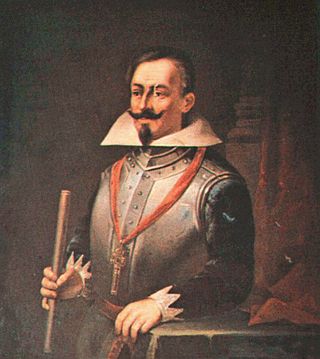
Alonso de Sotomayor y Valmediano was a Spanish conquistador from Extremadura, and a Royal Governor of Chile.
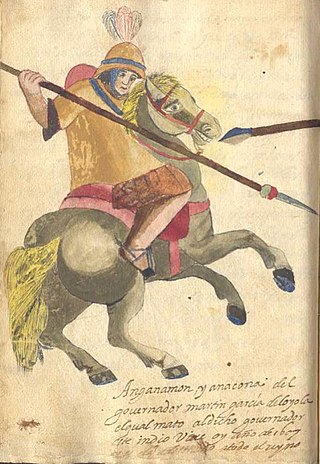
The Destruction of the Seven Cities is a term used in Chilean historiography to refer to the destruction or abandonment of seven major Spanish outposts in southern Chile around 1600, caused by the Mapuche and Huilliche uprising of 1598. The Destruction of the Seven Cities, in traditional historiography, marks the end of the Conquest period and the beginning of the proper colonial period.

Diego de Rosales was a Spanish chronicler and author of Historia General del Reino de Chile.
The Battle of Mataquito was fought in the Arauco War on April 30, 1557, between the forces of the Spanish governor, Francisco de Villagra, and Mapuche headed by their toqui Lautaro. It was a surprise attack, carried out at dawn, on Lautaro's fortified camp between a wooded mountain and the shore of the Mataquito River. The battle is notable for ending Mapuche designs on Santiago, while also avenging the death of former governor Pedro de Valdivia, who had been killed by Lautaro's warriors four years earlier.
The Battle of Millarapue that occurred November 30, 1557 was intended by the Toqui Caupolicán as a Mapuche ambush of the Spanish army of García Hurtado de Mendoza that resulted in a Spanish victory when the ambush failed.
Illangulién, Quiromanite, Queupulien or Antiguenu, was the Mapuche toqui elected to replace Lemucaguin or Caupolicán the younger in 1559 following the Battle of Quiapo to his death in battle in the Battle of Angol in 1564.
Caupolicán the Younger according to Juan Ignacio Molina was the son of the toqui Caupolicán. He was made toqui following the capture and execution of his father in 1558. He continued the first Mapuche rising against the Spanish conquistadors in 1558 and commanded the Mapuche army in constructing a pukara at Quiapo to block García Hurtado de Mendoza from rebuilding a fort in Arauco completing the chain of forts for suppression of their rebellion. In the Battle of Quiapo the Mapuche suffered a terrible defeat and there Caupolicán the younger died. His successor as toqui was Illangulién.
Paineñamcu or Paynenancu or Alonso Diaz, was the Mapuche toqui from 1574 to 1584. Alonso Diaz was a mestizo Spanish soldier offended because the Governor of Chile did not promote him to the officer rank of alféres, who subsequently went over to the Mapuche in 1572. He took the Mapuche name of Paineñamcu and because of his military skills was elected toqui in 1574 following the death of Paillataru.
Cayancura, or Cayeucura, was a Mapuche leader native to the region of Marigüenu, chosen as toqui in 1584 to replace the captured Paineñamcu. His one great operation was an attempted siege of the fort at Arauco that failed, leading to his abdication of his office in favor of his son Nangoniel in 1585.
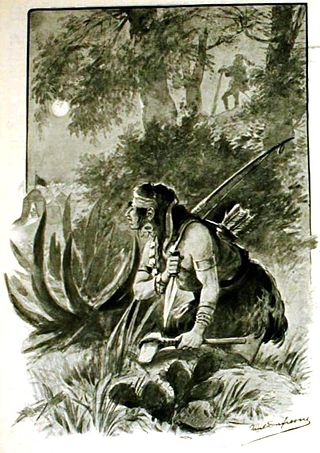
Lientur was the Mapuche toqui from 1618 to 1625. He was the successor to Loncothegua. Lientur with his vice toqui Levipillan was famed for his rapid malóns or raids. Because of his ability to slip back and forth over the Spanish border between its fortresses and patrols and raid deep into Spanish territory north of the Bio-Bio River without losses he was called the Wizard by the Spanish.
During the siege of Concepcion of the Arauco War, 20,000 warriors of the army of the Mapuche laid siege to the Spanish garrison and civil population in the fortress of Concepcion, Chile.
Millalelmo or Millarelmo was a Mapuche military leader in the second great Mapuche rebellion that began in 1561 during the Arauco War. Probably the toqui of the Arauco region, he commanded the Mapuche army of that area at the siege of Arauco from May 20 to June 30, 1562.
Pedro de Avendaño a Spanish soldier that had arrived in Chile with the army of García Hurtado de Mendoza in 1557. He distinguished himself in the Battle of Millarapue. He later served in the garrison of Cañete under captain Alonso de Reinoso. Reinoso eventually found an Indian who betrayed the location of the fugitive Mapuche toqui Caupolicán. Avendaño, with 50 men and the traitorous Indian as a guide, marched in stormy weather into the mountains to Pilmaiquén and captured Caupolicán as he was planning a new counter-offensive against the Spanish, near the modern Antihuala, on February 5, 1558. He brought the toqui back to Cañete where he was eventually executed by impalement at the order of corregidor Reinoso.
Guanoalca was the Mapuche toqui (leader) elected in 1586 following the death in battle of the previous toqui, Cadeguala, killed in a duel with the garrison commander of the Spanish fort at Purén in 1586. He returned to continue the siege and forced the Spanish to evacuate the fort, which he then destroyed.
Pailacar or Paylacar was a leader of Purén, who led a force of 2000 warriors in the defeat of the Spanish army of Don Miguel Avendaño de Velasco in the Battle of Purén in September 1570.
Butapichón or Butapichún or Putapichon was the Mapuche toqui from 1625 to 1631, as successor to Lientur. After the death of Quepuantú in 1632 he became toqui once again from 1632 to 1634.
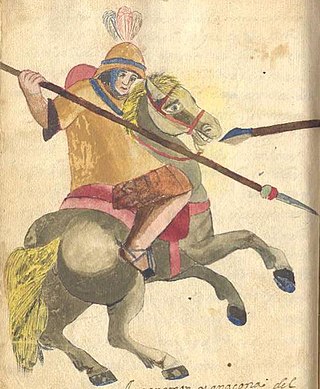
Anganamón, also known as Ancanamon or Ancanamun, was a prominent war leader of the Mapuche during the late sixteenth and early seventeenth centuries and a Toqui from. Anganamón was known for his tactical innovation of mounting his infantry to keep up with his cavalry.
References
- ↑ Indigenous war time leader in what is now the modern-day Chile region of South America.
- ↑ Pedro Mariño de Lobera, Crónica del Reino de Chile, Cap. XXXV: Diego de Rosales, “Historia General del Reino de Chile”, Flandes Indiano, Tomo II, Capítulos LII, LIII, LIV
- 1 2 Wilson, J. G.; Fiske, J., eds. (1900). . Appletons' Cyclopædia of American Biography . New York: D. Appleton.
